|
|
| |
|
 | Search: |
|
|
|
|
|
 |
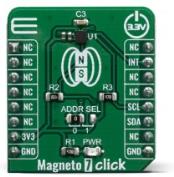
|
|
Magneto 7 Click is a high-resolution magnetic sensor Click board™ which allows contactless orientation sensing. It features the BM1422AGMV, a complete integrated solution with magneto-impedance (MI) elements, low-noise analog AD converter, and digital signal processing (DSP) sections, on the same die. Thanks to the internal DSP processing, the BM1422AGMV can output the absolute movement detection over the serial interface as a bit stream. The BM1422AGMV IC is ideal for using in various applications, such as wristwatches, smartphones, tablets, etc.
Magneto 7 click is supported by a mikroSDK compliant library, which includes functions that simplify software development. This Click board™ comes as a fully tested product, ready to be used on a system equipped with the mikroBUS™ socket.
|
|
|
|
|
 |
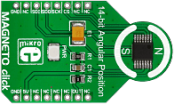
|
|
Magneto click carries an AS5048A contactless magnetic angle position sensor. The sensing circuitry relies on the Hall Effect to detect the vector of a nearby magnetic field in a 360° two-dimensional plane parallel to the surface of the chip. AS5048A delivers precise angle measurements down to 0.05° in 14-bit resolution. Its accuracy is not impeded (up to a point) by misalignment, air gap variations, temperature variations, even stray magnetic fields. The PWM outputs the absolute position information. Additionally, the magnet's zero position is programmable (via SPI). Magneto click communicates with the target MCU through the mikroBUS SPI interface (CS, CLK, MISO, MOSI). Designed to use a 5V power supply. |
|
|
|
 |
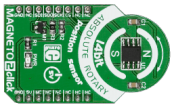
|
|
Magneto 2 click is a mikroBUS™ add-on board with Melexis's MLX90316 monolithic rotary position sensor. Sensing flux density with the IC surface of the MLX90316 allows the click to decode the absolute rotary (angular) position from 0 to 360 degrees.
In combination with the correct library, the magnetic flux density of a small magnet (diametral magnetisation) rotating above the IC can be measured in a non-contacting way.
The sensor enables the design of novel generation of non-contacting rotary position sensors that are frequently required for both automotive and industrial applications.
Magneto 2 click communicates with the target MCU through the mikroBUS™ SPI bus. The board is designed to use a 5V power supply only. |
|
|
|
 |
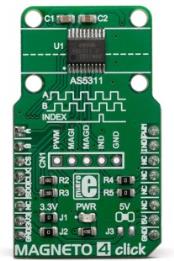
|
|
Magneto 4 click is a high-resolution magnetic encoder Click board™ which allows contactless motion sensing down to 0.5µm. It features the AS5311, a complete integrated solution with Hall elements, low-noise analog front-end, and digital signal processing (DSP) sections, on the same die. Thanks to the internal DSP processing, the AS5311 can output the absolute movement detection over the serial interface as a bit stream, or as a PWM signal. The AS5311 IC also offers a high-resolution incremental output with the additional index option. The device is supposed to be used with the multi-pole magnetic strip or ring.
Magneto 4 click is supported by a mikroSDK compliant library, which includes functions that simplify software development. This Click board™ comes as a fully tested product, ready to be used on a system equipped with the mikroBUS™ socket.
|
|
|
|
 |
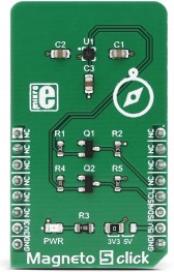
|
|
Magneto 5 click is a very accurate and reliable magnetic sensor device, which features the MEMSIC MMC34160PJ, a 3-axis magnetic sensor IC. MMC34160PJ IC features an onboard signal processing and I2C communication, simplifying the application development and reducing the host MCU load. It is a very accurate sensor, which can sense the heading direction with the precision of ±1°, with the full scale magnetic field detection of ±16 G. The device also has a RESET function, which eliminates measurement offset errors and restores the internal magnetic field orientation. |
|
|
|
 |

|
|
Bi Hall click is a simple solution for adding a bipolar Hall switch to your design. It carries the Melexis US2882 bipolar Hall-effect switch and a 74LVC1T45 single bit, dual supply transceiver. A bipolar Hall effect sensor is sensitive to both north and south pole magnetic fields. Bi Hall click outputs a HIGH logic level when exposed to a south pole magnetic field, and a LOW logic level when exposed to a north pole magnetic field. When removed from a magnetic field, the logic level stays in its previous state. The US2882 IC integrates a Schmitt trigger with hysteresis, thus preventing output oscillation near the switching point between alternating magnetic poles. Bi Hall click communicates with the target board through the mikroBUS INT line. It's designed to use either a 3.3V or a 5V power supply. |
|
|
|
 |
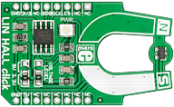
|
|
LIN HALL click carries an MLX90242 linear Hall sensor IC (with built-in active error correction circuitry) and an MCP3201 12-bit ADC. It outputs a signal that is proportional to the flux density of a magnetic field - a north magnetic field will increase the output value while a south magnetic field will cause it to decrease. The ratiometric output allows you to infer the linear or rotary position of a target object by placing magnets on it. LIN HALL click communicates with the target board through the mikroBUS SPI lines (CS, CSK, MISO). The board is designed to use either a 3.3V or a 5V power supply. |
|
|
|
 |
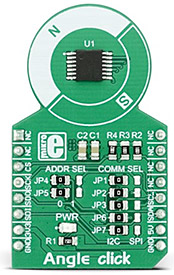
|
|
Angle click is a precise Hall-effect angle sensing click board that can be used to measure the rotational angle of the magnetic field in the X-Y plane above it (parallel to the surface of the click), through the whole range of 360°. The click yields very precise results for both off-axis and axis operation, which make it a perfect choice for precise measuring of the rotational angle in a wide range of different high-speed applications, for example in the automotive industry: electronic power steering, transmission, torsion bar, or the motor shaft rotation.
Angle click features the A1335 Hall-effect angle sensing IC, made by Allegro MicroSystems LLC. This IC measures the magnetic field angular vector, based on the actual physical reading of the integrated Hall-effect sensor, as well as the user selected parameters, such as the digital filtering, dynamic range and scaling. The integrated 32bit MCU ensures that the processed data is delivered with a minimal delay and it has enough power to provide the complex processing of the input values so that the measurement remains fast, precise and linear. |
|
|
|
 |

|
|
Angle 2 click is a magnetic rotational sensor which relies on the ultra-fast MA700 angular sensor IC. Due to a high data output rate of 500kHz, the MA700 IC is able to provide a reliable absolute angular positional data at speeds up to 100,000 RPM. This can be achieved by utilizing the advanced Spinaxis technology based on a direct angle sampling approach, instead of using the extensive arctangent computations and other similar solutions. This also allows for relaxed mechanical tolerances, allowing even the off-axis magnetic field to be used.
It comes in the package which also includes the mikroSDK™ software and a library with all the functions. The Click board™ comes as a fully tested and approved prototype, making it a reliable device ready to use on the development board.
|
|
|
|
 |
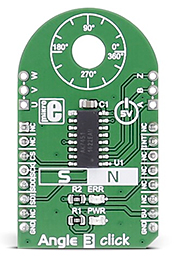
|
|
Angle 3 click carries the AK7451, a magnetic rotational angle sensor. The click is designed to run on a 5V power supply. It communicates with the target microcontroller over SPI interface, with additional functionality provided by the INT pin on the mikroBUS™ line. |
|
|
|
 |
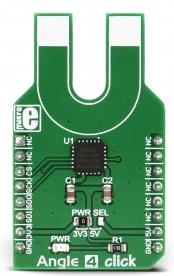
|
|
Angle 4 click is an angular magnetic rotary sensor, which can be used as a rotary encoder. With the help of the AEAT-8800-Q24, an integrated 10 to 16-bit programmable angular magnetic encoder, the Angle 4 click can sense the magnetic field rotation aligned with the center of the sensor, over the whole range of 360°. The absolute angular position can be read from the SPI interface. The sensor IC itself offers a versatile contactless rotation sensing platform, with the ability to fine-tune several important working parameters, such as the resolution, zero position, direction, hysteresis, and more. |
|
|
|
 |
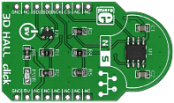
|
|
3D Hall click carries the MLX90333 Triaxis Hall sensor, capable of detecting the position of any magnet in nearby space. It does so by being sensitive to three components of flux density (BX, BY, BZ). The chip functions as a contactless position sensor for any type of magnet, capable of measuring its rotational, linear and 3D displacement with a high degree of precision. Contactless coupling ensures resistance against wear and environmental contaminants such as dirt and dust. The on-chip signal processing circuitry simplifies integration. The board communicates with the target MCU through the mikroBUS SPI interface (CS, SCK, MISO, MOSI). The board is designed to use a 5V power supply only. |
|
|
|
 |
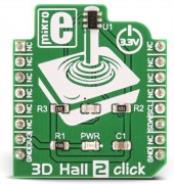
|
|
3D Hall 2 click is a very accurate magnetic field sensing Click board™, used to sense the magnetic field strength in three perpendicular axes. It relies on a TLV493D-A1B6, a low power 3D magnetic sensor from Infineon. This sensor has a separate Hall sensor for each axis, which allows a very reliable magnetic field sensing in 3D space, offering basis for accurate angle calculations. The TLV493D-A1B6 sensor uses industry standard I2C communication interface and requires a very low count of external components. The I2C interface is also used for the chip reset, so the sensor features a very low count of pins. |
|
|
|
 |

|
|
3D Hall 3 click is a very accurate, magnetic field sensing Click board™, used to measure the intensity of the magnetic field across three perpendicular axes. It is equipped with the LIS2MDL, a low power 3D magnetic sensor. This IC has a separate Hall sensing element on each axis, which allows a very accurate and reliable measurement of the magnetic field intensity in a 3D space, offering a basis for accurate positional calculations. Both I2C and SPI communication protocols are supported by the LIS2MDL. This sensor IC features a powerful programmable interrupt engine, allowing firmware optimization.
3D Hall 3 click is supported by a mikroSDK compliant library, which includes functions that simplify software development. This Click board™ comes as a fully tested product, ready to be used on a system equipped with the mikroBUS™ socket.
|
|
|
|
 |
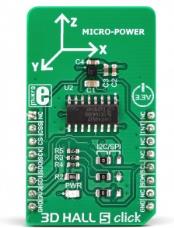
|
|
3D HALL 5 click is a very accurate, magnetic field sensing Click board™, used to measure the intensity of the magnetic field across three perpendicular axes. It is equipped with the IIS2MDCTR, a low power 3D magnetic sensor IC, from STMicroelectronics. This IC has a separate Hall sensing element on each axis, which allows a very accurate and reliable measurement of the magnetic field intensity in a 3D space, offering a basis for accurate positional calculations. The IIS2MDCTR magnetic sensor IC offers two industry-standard interfaces: both I2C and SPI communication protocols are supported by this IC. This sensor IC also features a powerful programmable interrupt engine with configurable polarity, type, source, and more. |
|
|
|
 |
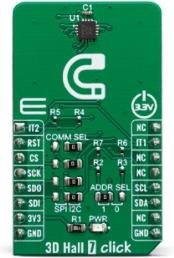
|
|
3D Hall 7 click is a very accurate, magnetic field sensing Click board™, used to measure the intensity of the magnetic field across three perpendicular axes. It is equipped with the AK09970N, a high sensitivity 3D magnetic sensor IC, from AsahiKASEI. This IC has a separate Hall sensing element on each axis, which allows a very accurate and reliable measurement of the magnetic field intensity in a 3D space, offering a basis for accurate positional calculations. The AK09970N magnetic sensor IC offers two industry-standard interfaces: both I2C and SPI communication protocols are supported by this IC. This sensor IC also features a powerful programmable interrupt engine with configurable polarity, switch event, and more.
3D Hall 7 click is supported by a mikroSDK compliant library, which includes functions that simplify software development. This Click board™ comes as a fully tested product, ready to be used on a system equipped with the mikroBUS™ socket.
|
|
|
|
 |
|
|

